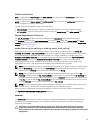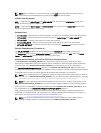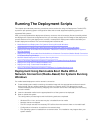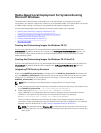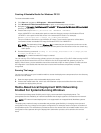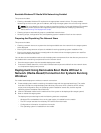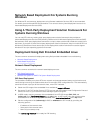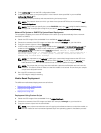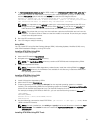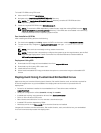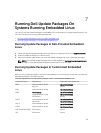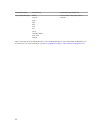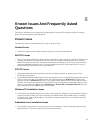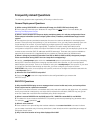
4. In /mnt/cdrom/isolinux/isolinux.cfg (for BIOS mode) or in /mnt/cdrom/EFI/BOOT/dtk_grub.cfg (for
UEFI mode), edit the cd install section to point to your customized start-up script. In other words,
add the share_script option and then use mkisofs to create the ISO image as follows:
mkisofs -o output.iso -b isolinux/isolinux.bin -c isolinux/boot.cat -no-
emul-boot -boot-load-size 4 -boot-info-table -pad -r -J -hide-joliet-trans-
tbl -eltorito-alt-boot -e efiboot.img -no-emul-boot isoimage
NOTE: It is important to use mkisofs to make your customized image because the ISO Linux
recognizes only the isolinux.cfg (and all files within /isolinux). If you do not use mkisofs, the
HAPI libraries of the DTK cannot load and most of the Dell Update Packages do not work.
NOTE: The scripts that you copy into the media are copied to the RAM disk and run from the
RAM disk. This task is done to make sure that the media is not locked. Ensure that your sample
scripts have valid path names.
5. Burn the ISO contents to a media.
6. Your ISO image is ready for booting.
Using RPMs
You can install DTK using Red Hat Package Manger (RPM), Yellowdog Updater, Modified (YUM) or any
other RPM Installation Manager, or using DTK tools.
Installing DTK RPMs Using RPM
To install DTK RPMs using RPM:
1. Mount the DTK media at /mnt/cdrom.
2. Navigate to the /mnt/cdrom/RPMs directory.
NOTE: The /mnt/cdrom/RPMs directory contains all DTK RPMs and the dependency RPMs.
3. Install the required DTK RPMs.
NOTE: To resolve the RPM dependency related issues, install the missing RPMs from /mnt/
cdrom/RPMs directory. If the RPMs are not available in this directory, install these RPMs from
the operating system media.
Installing DTK RPMs Using YUM
To install DTK RPMs using YUM:
1. Install YUM and the dependency RPMs.
2. Mount the DTK iso to /mnt/cdrom.
3. Create a repository file (for example, dtk.repo) for the required operating system in a writable
location. The corresponding RPMs for the operating system are located at
/mnt/cdrom/RPMs/<OS>,
where OS can be Red Hat Enterprise Linux 5 or Red Hat Enterprise Linux 6.
For example, to deploy DTK RPMs on RHEL 6.x, you can use the following content in dtk.repo file:
[DTK_RHEL6]
name=DTK_RHEL6
baseurl=file:///mnt/cdrom/RPMs/rhel6/
enabled=true
4. Use the following command to install DTK RPMs: yum install -c dtk.repo -y <RPM>, where
<
RPM> can be DTK binaries.
NOTE: For both installations, the raidcfg and syscfg binaries and libraries are installed at /opt/
dell/toolkit/bin. The racadm binaries are installed at /opt/dell/srvadmin/bin and /opt/dell/
srvadmin/sbin.
Installing DTK RPMs Using DTK Tools
61



